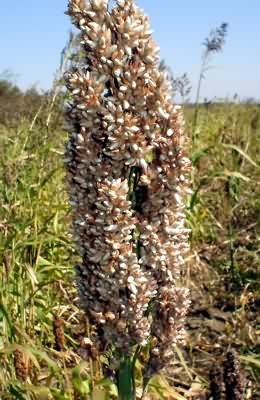Diseases
Sphacelotheca sorghi (Link) Clinton - Covered Smut of Sorghum
Systematic position.
Kingdom Fungi, division Basidiomycota, class Basidiomycetes, order Ustilaginales, family Ustilaginaceae, genus Sphacelotheca.Synonyms.
Sporisporium sorghi Link, Ustilago sorghi Passerini, Ustilago tulasnei Kuhn, Cintractia sorghi-vulgaris Clinton, Endothlaspis sorghi Sorokin, Sphacelotheca sorokiniana Ciferri.Biological group.
Heterotroph.Morphology and biology.
The pathogen of the disease in its development cycle forms teliospores (wintering stage of the fungus) and sporidia. Teliospores are spherical or roundish, tinted, smooth, 4.8 to to 8.5 mkm in diameter. At sprouting they form three- or four-cellular basidium with laterally and apically growing sporidia. Sporidia are oblong, with slightly rounded ends, or spindle-shaped, 2.9 to 18.5 mkm. The first signs of affection of sorghum with the Covered Smut are noticeable after ejection of inflorescences, when smut sori start to develop instead of the flower elements, reaching 0.5-1.0 cm in size. More often all ovaries of the inflorescences are affected, but occasionally part of them remains unaffected, and normal caryopses are formed. Diseased panicle does not hypertrophy, and glume shape and size remain unchanged. The sori are covered with a dense light capsule which collapses during harvest, thus releasing teliospores and polluting grain. The source of infection is the infected seeds. Contamination of the plants occurs only during the sprouting stage.Distribution.
The first time the Covered Smut of Sorghum was registered in Russia was in 1890. Now the disease is shown on sorghum and Sudan grass everywhere in all territories of the former USSR.Ecology.
The Fungus Sph. sorghi can grow and develop at temperatures from 10 to 32°C. The soil temperature 18-23°C and soil humidity 15-20% during the period of seed germination are optimal for the contamination of plants.Economic significance.
The pathogen of the disease has a suppressive action on the growth and development of affected plants. Losses of corn yield correspond to the percent of disease distribution in crops. Protective measures are cultivation of resistant varieties and hybrids, presowing seed treatment.Reference citations:
Doshimov U.D. 1982. Sorghum smut fungi. Tashkent: Fan, 68 p. (in Russian).Gutner L.S. 1941. Smut fungi. Moscow, 383 p. (in Russian).
Silaev A.I. 2005. Biologic and toxicological substantiation of the adaptive protection of sorghum from the smut disease in the Volga region. PhD Thesis. St.Petersburg: VIZR, 47 p. (in Russian).


